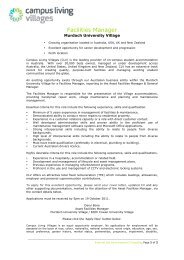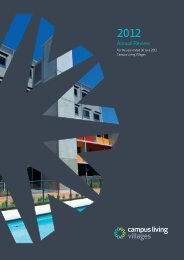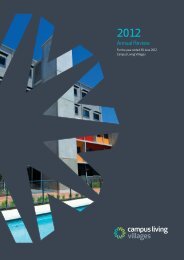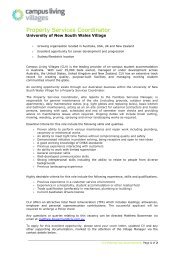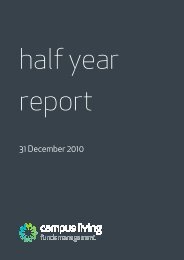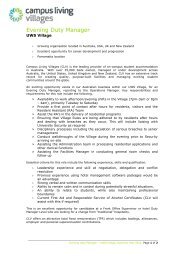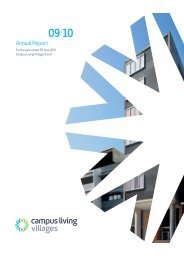Annual Report 10/11 - Campus Living Villages
Annual Report 10/11 - Campus Living Villages
Annual Report 10/11 - Campus Living Villages
You also want an ePaper? Increase the reach of your titles
YUMPU automatically turns print PDFs into web optimized ePapers that Google loves.
NOTES TO THE CONSOLIDATED FINANCIAL STATEMENTS<br />
FOR THE YEAR ENDED 30 JUNE 20<strong>11</strong><br />
A$’000<br />
<strong>Campus</strong> <strong>Living</strong> <strong>Villages</strong> <strong>Annual</strong> <strong>Report</strong> <strong>10</strong>/<strong>11</strong><br />
<strong>Campus</strong> <strong>Living</strong> Australia Trust<br />
The finance cost is charged to the income statement over the lease period so as to produce a constant periodic rate of<br />
interest on the remaining balance of the liability for each period. The property, plant and equipment acquired under<br />
finance leases is depreciated over the shorter of the asset’s useful life and the lease term.<br />
Leases in which a significant portion of the risks and rewards of ownership are not transferred to the consolidated entity<br />
as lessee are classified as operating leases. Payments made under operating leases (net of any incentives received from<br />
the lessor) are charged to the income statement on a straight-line basis over the period of the lease.<br />
g) Business combinations<br />
The purchase method of accounting is used to account for all business combinations, including business combinations<br />
involving entities or businesses under common control, regardless of whether equity instruments or other assets are<br />
acquired. Cost is measured as the fair value of the assets given, equity instruments issued or liabilities incurred or<br />
assumed at the date of exchange plus costs directly attributable to the acquisition. Where equity instruments are issued<br />
in an acquisition, the fair value of the instruments is their published market price as at the date of exchange unless, in rare<br />
circumstances, it can be demonstrated that the published price at the date of exchange is an unreliable indicator of fair<br />
value and that other evidence and valuation methods provide a more reliable measure of fair value. Transaction costs<br />
arising on the issue of equity instruments are recognised directly in equity.<br />
Identifiable assets acquired and liabilities and contingent liabilities assumed in a business combination are measured<br />
initially at their fair values at the acquisition date, irrespective of the extent of any minority interest.<br />
The excess of the cost of acquisition over the fair value of the consolidated entity’s share of the identifiable net assets<br />
acquired is recorded as goodwill. If the cost of acquisition is less than the consolidated entity’s share of the fair value of<br />
the identifiable net assets of the subsidiary acquired, the difference is recognised directly in the income statement, but<br />
only after a reassessment of the identification and measurement of the net assets acquired.<br />
Where settlement of any part of cash consideration is deferred, the amounts payable in the future are discounted to their<br />
present value as at the date of exchange. The discount rate used is the entity’s incremental borrowing rate, being the rate<br />
at which a similar borrowing could be obtained from an independent financier under comparable terms and conditions.<br />
Identification of the acquirer<br />
The acquirer in a business combination must be identified. The acquirer is the combining entity that obtains control of the<br />
other combining entities or businesses. Control is the power to govern the financial and operating policies of an entity or<br />
business so as to obtain benefits from its activities.<br />
In the event that the acquirer identified is not the legal parent of the business combination, the issued capital of the<br />
consolidated entity reflects the issued capital of the acquirer amended for the appropriate fair value adjustments of the<br />
business combination.<br />
h) Impairment of assets<br />
Goodwill is not subject to amortisation and is tested annually for impairment or more frequently if events or changes in<br />
circumstances indicate that it might be impaired. Other assets are reviewed for impairment whenever events or changes<br />
in circumstances indicate that the carrying amount may not be recoverable. An impairment loss is recognised for the<br />
amount by which the asset’s carrying amount exceeds its recoverable amount. The recoverable amount is the higher of an<br />
asset’s fair value less costs to sell or value in use. For the purposes of assessing impairment, assets are grouped at the<br />
lowest levels for which there are separately identifiable cash inflows which are largely independent of the cash inflows<br />
from other assets or consolidated entity’s assets (cash-generating units). Non-financial assets other than goodwill that<br />
suffered impairment are reviewed for possible reversal of the impairment at each reporting date.<br />
i) Cash and cash equivalents<br />
For cash flow statement presentation purposes, cash and cash equivalents include cash on hand, deposits held at call with<br />
financial institutions, other short-term, highly liquid investments with original maturities of three months or less that are<br />
readily convertible to known amounts of cash and which are subject to an insignificant risk of changes in value, and bank<br />
overdrafts. Bank overdrafts are shown within borrowings in current liabilities on the balance sheet.<br />
64



